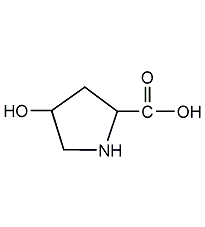L-4-Hydroxyproline

Structural formula
| Business number | 014P |
|---|---|
| Molecular formula | C5H9NO3 |
| Molecular weight | 131.13 |
| label |
L-Hydroxyproline, 4-hydroxy-2-carboxypyrrolidine, trans-4-hydroxy-L-proline, (-)-(2S,4R)-4-Hydroxyproline, 4-Hydroxy-2-pyrrolidinecarboxylin acid, intermediates, Biochemical reagents |
Numbering system
CAS number:51-35-4
MDL number:MFCD00064320
EINECS number:200-091-9
RTECS number:TW3586500
BRN number:81441
PubChem number:24880041
Physical property data
1. Properties: colorless rhombus or needle-shaped crystals. Optically active.
2. Density (g/mL, 25/4℃): 1.395
3. Relative vapor density (g/mL, air=1): Undetermined
4. Melting point (ºC): 274
5. Boiling point (ºC, normal pressure): Undetermined
6. Boiling point (ºC, 5.2kPa): Undetermined
7. Refractive index: Undetermined
8. Flash point (ºC): Undetermined
9. Specific rotation (º): [α]D-76.5° (C=2.5, in water)
10. Autoignition point or ignition temperature (ºC): Undetermined
11. Vapor pressure ( kPa, 25ºC): Undetermined
12. Saturated vapor pressure (kPa, 60ºC): Undetermined
13. Heat of combustion (KJ/mol): Undetermined
14. Critical temperature (ºC): Undetermined
15. Critical pressure (KPa): Undetermined
16. Oil-water (octanol/water) partition coefficient relationship Value: Undetermined
17. Explosion upper limit (%, V/V): Undetermined
18. Explosion lower limit (%, V/V): Undetermined
19. Solubility: Solubility in water: 288.6g/L at 0℃, 361.1g/L at 25℃, 451.8g/L at 50℃, 516.7g/L at 65℃. Very slightly soluble in ethanol, insoluble in ether.
Toxicological data
1. Mutagenicity: sister chromatids exchangeTEST system: human lymphocytes: 10mgL
Ecological data
None
Molecular structure data
1. Molar refractive index: 29.49
2. Molar volume (cm3/mol): 93.9
3. Isotonic specific volume (90.2K ): 263.9
4. Surface tension (dyne/cm): 62.2
5. Polarizability (10-24cm3): 11.69
Computing chemical data
1. Hydrophobic parameter calculation reference value (XlogP): -3.3
2. Number of hydrogen bond donors: 3
3. Number of hydrogen bond acceptors: 4
p>
4. Number of rotatable chemical bonds: 1
5. Number of tautomers:
6. Topological molecular polar surface area (TPSA): 69.6
p>
7. Number of heavy atoms: 9
8. Surface charge: 0
9. Complexity: 125
10. Number of isotope atoms : 0
11. Determine the number of atomic stereocenters: 2
12. Uncertain number of atomic stereocenters: 0
13. Determine the chemical bond configuration Number of centers: 0
14. Number of uncertain chemical bond stereocenters: 0
15. Number of covalent bond units: 1
Properties and stability
1. Found in tobacco leaves.
Storage method
1. Protect from light and store in a sealed container.
Synthesis method
None
Purpose
Used as biochemical reagents.
extended-reading:https://www.bdmaee.net/wp-content/uploads/2022/08/31-13.jpgextended-reading:https://www.morpholine.org/pc41/extended-reading:https://www.bdmaee.net/wp-content/uploads/2022/08/-T120-1185-81-5-didodecylthio-dibutyltin.pdfextended-reading:https://www.newtopchem.com/archives/45044extended-reading:https://www.cyclohexylamine.net/pc-cat-nmm-addocat-101-tertiary-amine-catalyst-nmm/extended-reading:https://www.bdmaee.net/wp-content/uploads/2021/05/2-10.jpgextended-reading:https://www.newtopchem.com/archives/44188extended-reading:https://www.bdmaee.net/cas-2273-43-0-2/extended-reading:https://www.newtopchem.com/archives/category/products/page/134extended-reading:https://www.cyclohexylamine.net/amine-catalyst-smp-delayed-catalyst-smp/


